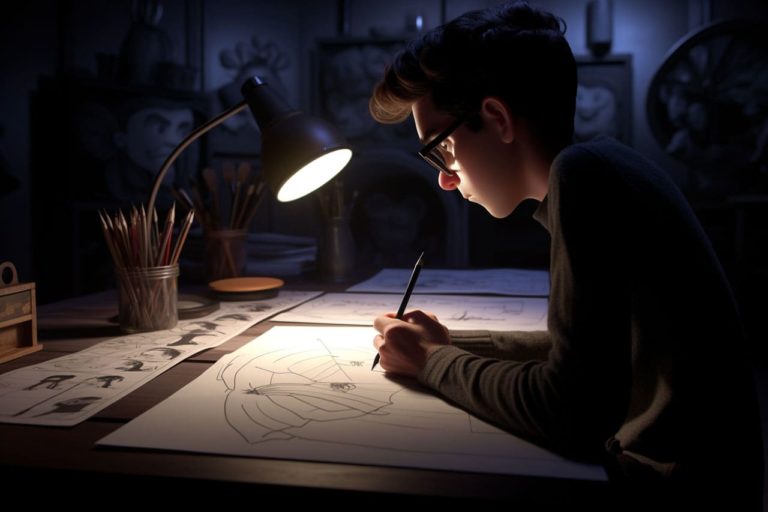Picture this: you’re sitting at your desk, a blank piece of paper before you, a pen in your hand, and a whirlwind of artistic ambition swirling in your head. You’re ready to unleash your inner da Vinci, to create something that’ll make the art world stop and take notice. But then, the pen touches paper, and instead of a masterpiece, you end up with a scribbled mess that looks like Picasso and a chicken had a doodling contest. Fear not, dear artists-in-training, for we’re about to dive into the mesmerizing world of inking techniques that’ll transform those pen drawings from chaotic squiggles to awe-inspiring creations.
The Pen: Your Trusty Sword of Art
Ah, the pen—an unassuming tool that holds within its slender form the power to create worlds, capture emotions, and turn thoughts into tangible art. It’s like a magic wand that, with a flourish, can summon lines that dance, shapes that captivate, and shading that adds depth and dimension. But wait, before you start waving that pen around like a wizard’s wand, let’s uncover the secrets of masterful inking.
The Art of Line Variation
Lines, my friends, are the building blocks of art. But, oh, what a dull world it would be if every line were the same! Enter line variation—the art of playing with line weight to create contrast and visual interest. Imagine a symphony where the conductor adds crescendos and diminuendos to make the music come alive. That’s what line variation does for your pen drawings.
Thick lines for bold statements, thin lines for delicate details—it’s like the calligraphy of art, a dance that gives your drawings rhythm and personality. So, whether you’re outlining a character or shading a landscape, remember that in the world of inking, lines aren’t just lines—they’re the storytellers of your artistic tale.
Embrace the Power of Hatching and Cross-Hatching
Hatching and cross-hatching—sounds like the battle cries of a medieval knight, doesn’t it? Well, in the realm of pen drawing, they’re your weapons for creating texture, shading, and depth. Hatching is all about using parallel lines to add value and tone to your drawings. It’s like adding layers of whispers that build up into a symphony of visual delight.
Cross-hatching, on the other hand, takes it a step further. It’s like hatching’s rebellious cousin who can’t sit still. You layer lines in crisscross patterns, creating shadows, highlights, and a sense of three-dimensionality that can turn a flat drawing into a living, breathing masterpiece.
The Elegance of Stippling
Stippling, my dear artists, is the fine art of creating images with dots—like Pointillism’s rebellious sibling who didn’t quite want to join the dots. It’s a technique that demands patience, a steady hand, and an appreciation for the beauty of detail.
With stippling, you’re not just drawing—you’re sculpting with dots, creating shades, textures, and gradients that give your pen drawings an elegance that’s nothing short of mesmerizing. Imagine the marvel of a picture made up of countless tiny dots, each one a masterpiece in itself. That, my friends, is the magic of stippling.
Cross Your Ts and Dot Your Is: Textures and Details
In the grand tapestry of art, textures and details are like the intricate patterns that add depth and complexity. From the rough bark of a tree to the fine fur of an animal, textures breathe life into your pen drawings. They make your subjects jump off the page and invite the viewer to touch, to feel the world you’ve crafted.
Details, on the other hand, are the breadcrumbs that lead your audience deeper into your artistic realm. They’re the freckles on a character’s face, the cracks in a weathered wall, the sparks in the eyes of your creation. Every detail is a story waiting to be discovered, a connection waiting to be forged between your art and its admirer.
From Scribbles to Masterpieces: Practice, Practice, Practice
Ah, my fellow budding artists, here’s a truth that echoes through the halls of creative history: practice makes progress. No one became a pen-wielding Picasso overnight. Just like mastering any craft, the path to artistry is paved with practice sessions, scribbles, and a healthy dose of trial and error.
So, don’t be discouraged by those early doodles that resemble a roller coaster gone rogue. Embrace them as part of your journey—the stepping stones to the masterpieces you’re destined to create. Fill sketchbooks with your lines, hatches, and stippling until they become as familiar as old friends. With every stroke, you’re honing your skills, crafting your style, and inching closer to that magical moment when your pen dances to the tune of your imagination.
Conclusion: Pen Power Unleashed
Ladies and gentlemen, as we conclude this artistic adventure, remember that pen drawing isn’t just about lines on paper—it’s about the stories you tell, the emotions you capture, and the worlds you create. With line variation, hatching, stippling, textures, and details at your fingertips, you’re armed with the tools of a true pen master.
So, whether you’re sketching for the joy of it or setting your sights on artistic greatness, let your pen be your guide, your companion, and your trusty sword of art. With each stroke, you’re not just drawing—you’re creating magic, one line at a time.
